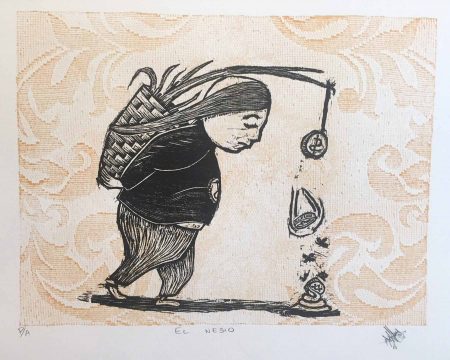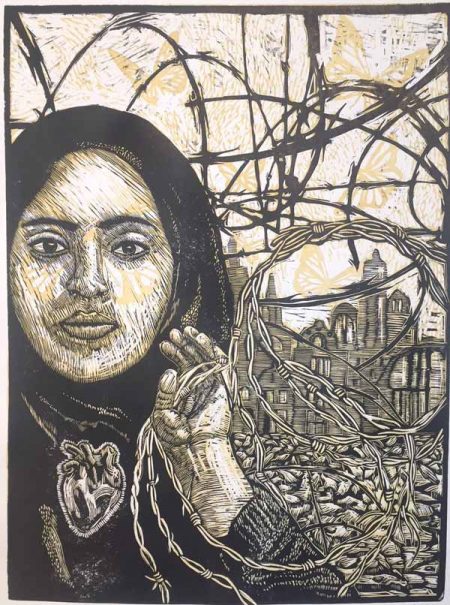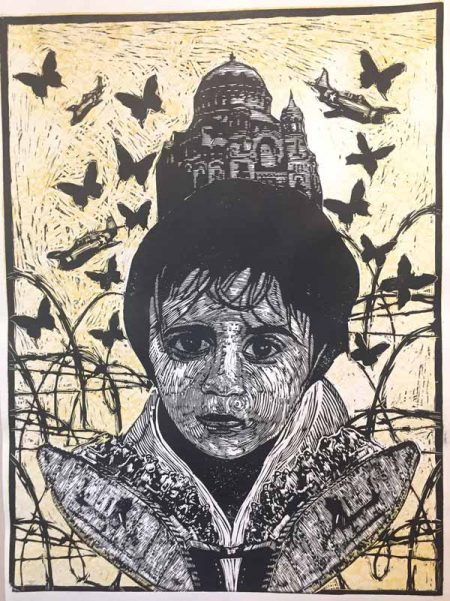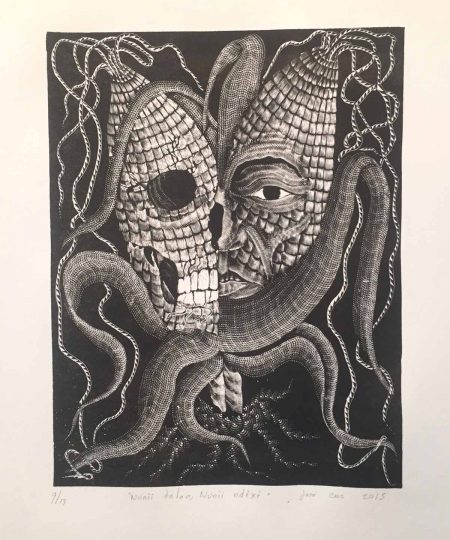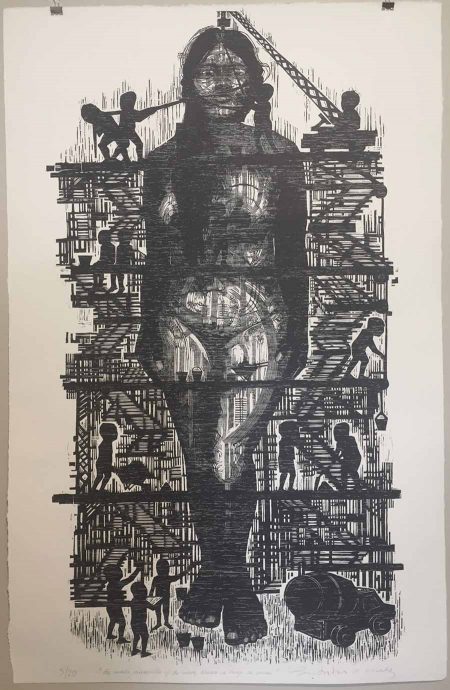woke – (adjective) \wōk\ : aware of and actively attentive to important facts and issues (especially issues of racial and social justice).
-Merriam Webster Dictionary (online)
There is a lot of talk in the world lately of people finally awakening to the plight of their fellow human beings. With technological ease of instantly conveyed information from all over the world, it is easier than ever to ‘get woke’ as it were, and possibly to become overwhelmed by it all in the meantime. Thankfully, visionaries are amongst us who have been ‘woke’ since before it was even coined as a description of social justice and who present to us difficult themes through the lens of great beauty. One such person is Saad Ghosn. Ghosn is the proverbial renaissance man – a physician and professor, artist and activist. He is perhaps best known in Cincinnati, Ohio artistic circles as the force behind S.O.S. (Save Our Souls) Art Cincinnati, whose work encourages and enables the “arts as vehicles for peace and justice and for a change.”
Ghosn’s latest efforts consists of a gathering of stunning prints from Oaxaca, Mexico, a state rich in natural splendor and a vast array of cultural insights, both traditional and modern. In the show Printed Voices from Oaxaca: Social and Cultural Reflections, presented at the Kennedy Heights Art Center, the themes encountered in a typical SOS show locally are explored via the work of printmakers from Oaxaca. Slavery, immigration issues, extreme poverty, abuses of power, and environmental degradation come to life in the vivid imagery present in the works on display.
Two themes in particular run especially strongly in the works chosen by Ghosn from well known and newly emerging Oaxacan artists. Migration and environmental degradation, inextricably linked by the financial structuring of capitalism as we know it, are explored in print after print, utilizing traditional modalities of folklore and printmaking techniques.
In the work entitled The Fool (El Necio), by BETA, a figure is walking with a basket upon his back, balanced with a strap across his forehead. The contents of the basket might be food for his family, or perhaps he is carrying this crop as employment, for dangling from one stem is a coin. Like the carrot on the end of a stick, always just out of reach to a beast of burden, so this poor ‘fool’ carries on in his laboring. But is he a fool? Workers of all sorts must toil endlessly for mere scraps of subsistence, especially in countries like Mexico.
If one desires to find the seed of most social injustice in the world at large, one need merely follow the money trail. This idea is expressed powerfully in a piece entitled Social Classes (Clases Sociales) by Mario Guzmán.
His statement reads “While the exploited works, the exploiter enjoys….” and thus it is so in this work. Printed in rich red ink on a stark white ground, the image portrays ominous skeletal figures. One clearly in power, larger and conveyed with all he should need, rides upon the head and neck of a much smaller figure who pedals a bicycle which carries not only himself and the fat cat upon his head, but his children as well. In a second print by Guzmán, Migrants (Migrantes), the notion of capitalism is at the root of migration and in the artist’s statement we read, “On this road, one faces death.”
In these works, the figures are shown as traveling, migrating and moving for work, downtrodden and nearly broken but carrying on nonetheless. Always moving. Sadly, it is often the most vulnerable populations in the world who must always be on the move, seeking livelihood or perhaps an escape from political violence. Two prints from YESCKA portray migration from places outside of Mexico, the Palestinian territories and Syria. Confronted with the portraits of two people, a Palestinian woman and a child from Syria, we know that these prints come from a place of knowing their struggles first hand.
These people look directly at the viewer, sharing their pain and struggles but also some tender local imagery as well. This gaze is a challenge to us not to look away, but to engage in an empathetic conversation with a fellow human being.
Another prevalent and related theme in this collection of prints is that of environmental degradation in the wake of irresponsible corporate practices. In a print from José Cruz entitled Núnil Tataa, Nunil Ndixi? (Native Corn or Genetically Modified Corn?) we see that even something seemingly as simple as growing one’s food is challenged by industry.
An untitled print from MERCADO portrays the stuff of nightmares – global chaos and nuclear destruction, violence and hopelessness. In fact, much of the work collected in this show could be said to hold such difficult concepts to ponder.
And yet, Saad Ghosn has worked his curatorial magic once again. While the themes presented are indeed difficult, they are presented with such tenderness and beauty as well as impeccable craft, the viewer is hard pressed to remain hopeless.
The work Of Yellow Corn and White Corn Was Made His Flesh by Ivan Baltista and Alberto Cruz conveys the sense of hope with which I left this show. In it the artists “collaborated on this piece symbolically representing a new construction on the identity of Oaxaca.” In this sizable work, Oaxaca is being rebuilt as a feminine figure. Perhaps this can be extended to the rest of the world as well. These are tumultuous times in which we live. It is emboldening to witness work from a relatively small state, which is so brutally in touch with not only its own tragic realities, but those of the world. We can look to these artists, and to the work of visionaries such as Saad Ghosn to find a gentle path forward, one with space and kindness for the most vulnerable.
Voices From Oaxaca, an exhibition partnership presented by SOS Art and the Kennedy Heights Arts Center is on display at KHAC, Mansion Gallery through November 12, 2017
–Amy Bogard
